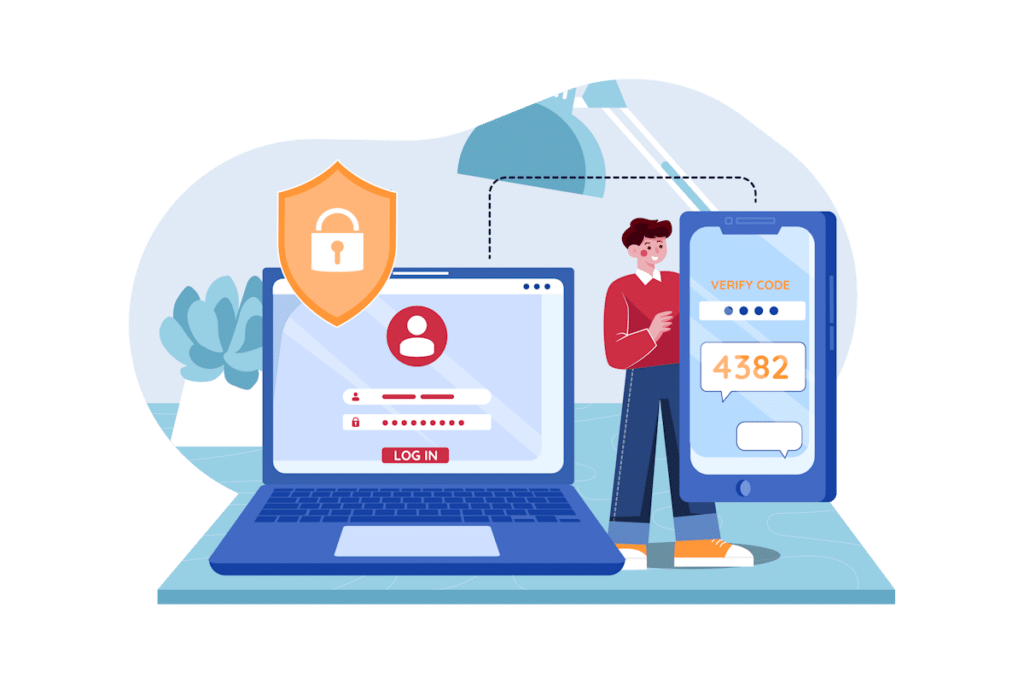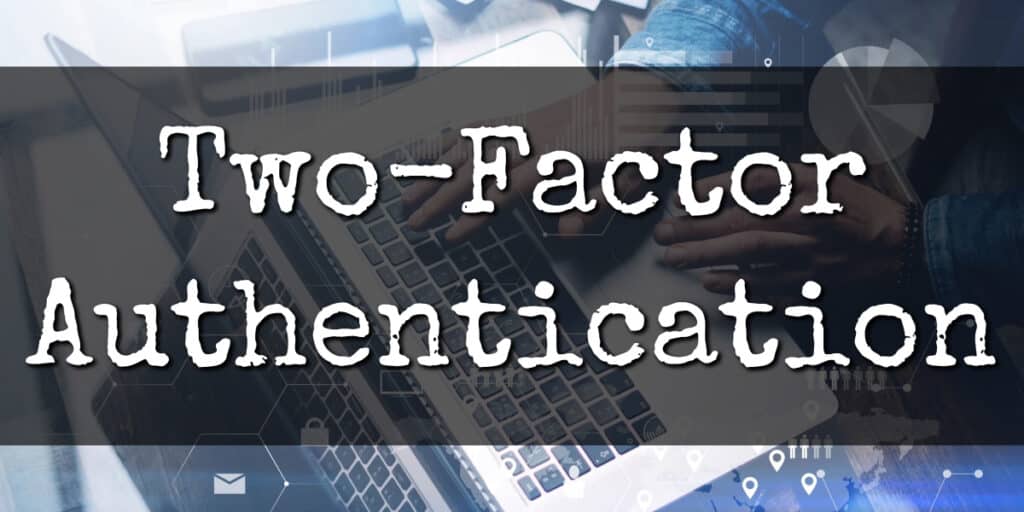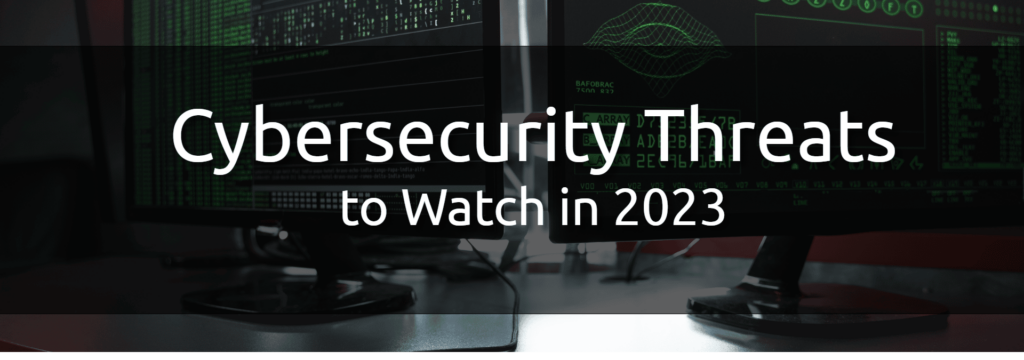Today, the need for robust security measures has never been more critical. “What is two-factor authentication?” you may ask. Two-factor authentication (2FA) and multi-factor authentication (MFA) have emerged as vital components in the fight against cyber threats, providing an extra layer of protection for sensitive systems and data.
But what exactly is 2FA, and why is it such an essential tool in the age of cybercrime? Let’s find out.
On This Page:
Key Takeaways
- Two-Factor Authentication (2FA) is a security process that combines two authentication factors for increased protection against credential theft and unauthorized access.
- Popular Two-Factor Authentication methods include SMS, TOTP, push notification, and hardware token solutions, each offering distinct benefits & drawbacks.
- Organizations can effectively implement 2FA to strengthen their security posture by addressing user adoption, technical compatibility & other challenges.
What is Two-Factor Authentication?

Two-factor authentication (2FA) is a security process that requires two distinct authentication factors to verify a user’s identity, thereby providing heightened protection for delicate systems and user authentication. This typically involves a combination of something you know (like a password) and something you have (such as a smartphone app).
By integrating these dual layers, 2FA substantially bolsters security compared to single-factor authentication (SFA), effectively guarding against common threats like phishing, social engineering, and brute-force attacks.
Think of two-factor authentication (2FA) like your house key and alarm system. Your key (something you have) unlocks your front door, and then you need to disarm the alarm system (something you know) to gain full access. Just having the key isn’t enough, and knowing the alarm code is useless without the key. Both are needed for full access, providing an extra layer of security.
Expanding on this concept is Multi-Factor Authentication (MFA), which encompasses 2FA but can include additional layers of security. While 2FA limits the process to two verification methods, MFA allows for two or more, such as adding biometric verification (something you are) to the mix. This diversity in authentication factors significantly enhances overall security, making MFA a more robust option for protecting against various cyber threats and potential credential compromises.
Why Two-Factor Authentication Matters
Passwords alone are vulnerable to a range of internal and external threats, including:
- Careless storage of login credentials
- Outdated hard drives
- Social engineering
- Brute-force, dictionary, and rainbow table attacks
Two-factor authentication plays a significant role in preventing unauthorized access, reducing the likelihood of data breaches, and securing online accounts and sensitive data against those who attempt to gain unauthorized access. By implementing 2FA, users are granted access only after successfully providing the required credentials, adding an extra layer of security.
Security experts advocate that users activate 2FA whenever feasible, as well as requesting it from services that process confidential user data but do not currently provide 2FA. This often involves the use of a verification security code as part of the authentication process. When users are required to approve authentication requests, 2FA enhances the security of vulnerable systems and data, thereby reducing the likelihood of data breaches.
The Role of Two-Factor Authentication in Business
Two-factor authentication (2FA) is beneficial for businesses for securing access to critical systems, protecting sensitive user data, and meeting compliance requirements. One common method involves sending an authentication code, also known as a verification code, to the user’s mobile phone. This additional layer of security helps organizations protect employee platforms, corporate accounts, proprietary software, bank accounts, and IRS access, among other sensitive systems.
Implementing 2FA in security protocols allows businesses to more effectively safeguard their valuable assets and reduce the risk of unauthorized access.
Types of Authentication Factors

The process of authentication involves three main types of factors: knowledge factors (like passwords and PINs), possession factors (such as hardware tokens and cards), and inherence factors (biometrics, for instance). Each factor plays a significant part in the multi-factor authentication process, adding a unique layer of security that helps confirm the user’s identity and ensuring that only authorized individuals have access to sensitive systems and data.
Knowledge Factors
Knowledge factors refer to information that is known by only the user, such as passwords or PINs, which are used to authenticate the user’s identity. They serve as the first line of defense in the authentication process and are the most commonly used authentication factor, offering an additional layer of security by requiring the user to possess knowledge that is unique to them.
Possession Factors
Possession factors refer to physical items, such as hardware tokens or cards, that are used to authenticate the user’s identity. By requiring users to possess a physical device or security key in addition to their password or knowledge factor, possession factors provide an additional layer of security, making it significantly more difficult for unauthorized individuals to access an account or system.
Inherence Factors
Inherence factors refer to unique biological traits of the user, such as fingerprints or facial recognition, which are employed to authenticate identity. By incorporating inherence factors into the 2FA process, it becomes more difficult for unauthorized individuals to impersonate the user and access user accounts.
Popular Two-Factor Authentication Methods

There are several popular 2FA methods, each offering unique advantages and challenges, which can influence the choice of the most suitable 2FA method for a particular organization or application.
SMS-Based 2FA
SMS-based 2FA is a security measure that involves sending verification codes to the user’s mobile device via SMS, which must be entered to gain access. While many users find this method convenient and straightforward, it should be noted that one-time passwords (OTPs) sent via SMS can be vulnerable to mobile phone number portability attacks, assaults on the mobile phone network, malware that can intercept or redirect text messages, and smishing (SMS phishing) attempts.
TOTP 2FA
Time-based one-time passwords (TOTP 2FA) are generated on the user’s device and must be entered within a specific time frame to gain access. TOTP 2FA is considered more secure than SMS-based 2FA due to its decreased vulnerability to interception and spoofing.
Additionally, TOTP-based 2FA does not require a phone number, allowing the authentication request to be sent to any device with the app installed.
Push Notification 2FA
Push notification 2FA is a security measure wherein users receive a push notification on their device, which they must approve in order to gain access. This method eliminates the potential for phishing, man-in-the-middle attacks, or unauthorized access, providing a more user-friendly and secure form of security compared to SMS-based 2FA.
Hardware Token 2FA
Hardware token 2FA is a form of authentication that utilizes physical security keys to verify the user’s identity, thereby providing an additional layer of security. When the physical key is connected to the device and access to a secure resource is attempted, the key communicates with the server to authenticate the identity of the user, ensuring that only authorized personnel can gain access to the accounts.
Industry Applications of Two-Factor Authentication
Two-factor authentication is used across various industries to protect sensitive data and meet compliance requirements. From healthcare to banking and retail, 2FA plays a crucial role in securing access to critical systems and information, ensuring that only authorized individuals can access sensitive data.
Healthcare

In the healthcare industry, 2FA is utilized to secure patient data and meet regulatory requirements such as HIPAA and DEA regulations for Electronic Prescriptions for Controlled Substances (EPCS). By implementing 2FA, healthcare organizations can provide secure access to patient data from personal devices, ensuring that only authorized individuals can access sensitive information and protecting against unauthorized access and data breaches.
Banking
In the banking industry, 2FA helps to:
- Protect against hacking attempts
- Strengthen the resiliency of banks by verifying user identities
- Safeguard sensitive information and transactions
- Improve overall security
- Safeguard both the institution and its customers
By requiring customers to provide a second form of authentication, such as a one-time password or push notifications sent to their mobile device, banks can enhance account security.
Retail
In the retail industry, 2FA is employed to authenticate user identities accessing networks from remote desktop or mobile devices. By requiring users to provide an additional layer of authentication when accessing sensitive systems, retail organizations can better protect their digital assets and reduce the risk of unauthorized access, ensuring the security of both the business and its customers.
How to Implement Two-Factor Authentication

Implementing two-factor authentication involves several steps:
- Choose a 2FA method: The first step is to choose the 2FA method that best suits your organization’s needs. This could be SMS-based 2FA, TOTP 2FA, push notification 2FA, or hardware token 2FA. You could also offer several 2FA authentication methods to allow users to choose which methods they use.
- Set up the 2FA system: Next, set up the chosen 2FA system. This could involve integrating it into your existing security infrastructure, configuring settings, and testing the system to ensure it works correctly.
- Educate users: It’s crucial to educate users about how to use the 2FA system and why it’s important. This includes teaching them how to use the 2FA method you’ve chosen and explaining the benefits of 2FA in terms of increased security.
- Enforce 2FA use: Once the 2FA system is set up and users are educated, it’s important to enforce its use. This could involve making 2FA mandatory for all users or for certain high-risk activities.
- Monitor and adjust: Finally, monitor the use of the 2FA system and adjust as necessary. This could involve making customer service more available for addressing any issues that arise, making changes to improve user experience, or updating the system as new 2FA technologies become available.
Summary
Two-factor authentication is a powerful security tool that can significantly enhance the protection of sensitive systems and data across various industries. By understanding the different authentication factors and methods, as well as the potential challenges and benefits of implementing 2FA, organizations can make informed decisions about the best security solutions for their needs.
Embracing 2FA can help organizations stay one step ahead in the ongoing battle against cyber threats and ensure the safety and security of their valuable assets.
Frequently Asked Questions
Is two-factor authentication (2FA) unhackable?
While two-factor authentication significantly enhances the security of an account, it is not completely unhackable. Cybercriminals have developed methods to bypass 2FA, usually through sophisticated phishing attacks or by exploiting vulnerabilities in the communication between the user and the authentication server. However, despite this, 2FA is still far more secure than relying on a single-factor authentication method, such as a password alone.
Should two-factor authentication be on or off?
Activating two-factor authentication is highly recommended as it provides an additional protective barrier for your account, safeguarding it against potential password breaches. Think of it like having a double-lock system on your door – even if a cybercriminal manages to figure out your username and password, they would still need the second authentication factor to gain access.
What is the difference between single-factor authentication and two-factor authentication?
Two-factor authentication requires two distinct factors for verifying a user’s identity, such as a password and a one-time code sent to a mobile device, while single-factor authentication relies on just one factor, like a password.
What is Passwordless Authentication?
Passwordless authentication is a security method that does not require the user to enter a password. Instead, it uses other forms of verification, such as biometric data (like fingerprints or facial recognition), a physical device (like a security key), or a link sent to the user’s email. This method eliminates the risks associated with password use, such as weak passwords, stolen credentials, using the same password for multiple accounts, and phishing attacks.
How does two-factor authentication protect against phishing attacks?
Two-factor authentication makes it more difficult for attackers to impersonate users and access their online accounts, providing an extra layer of protection against phishing attacks.



